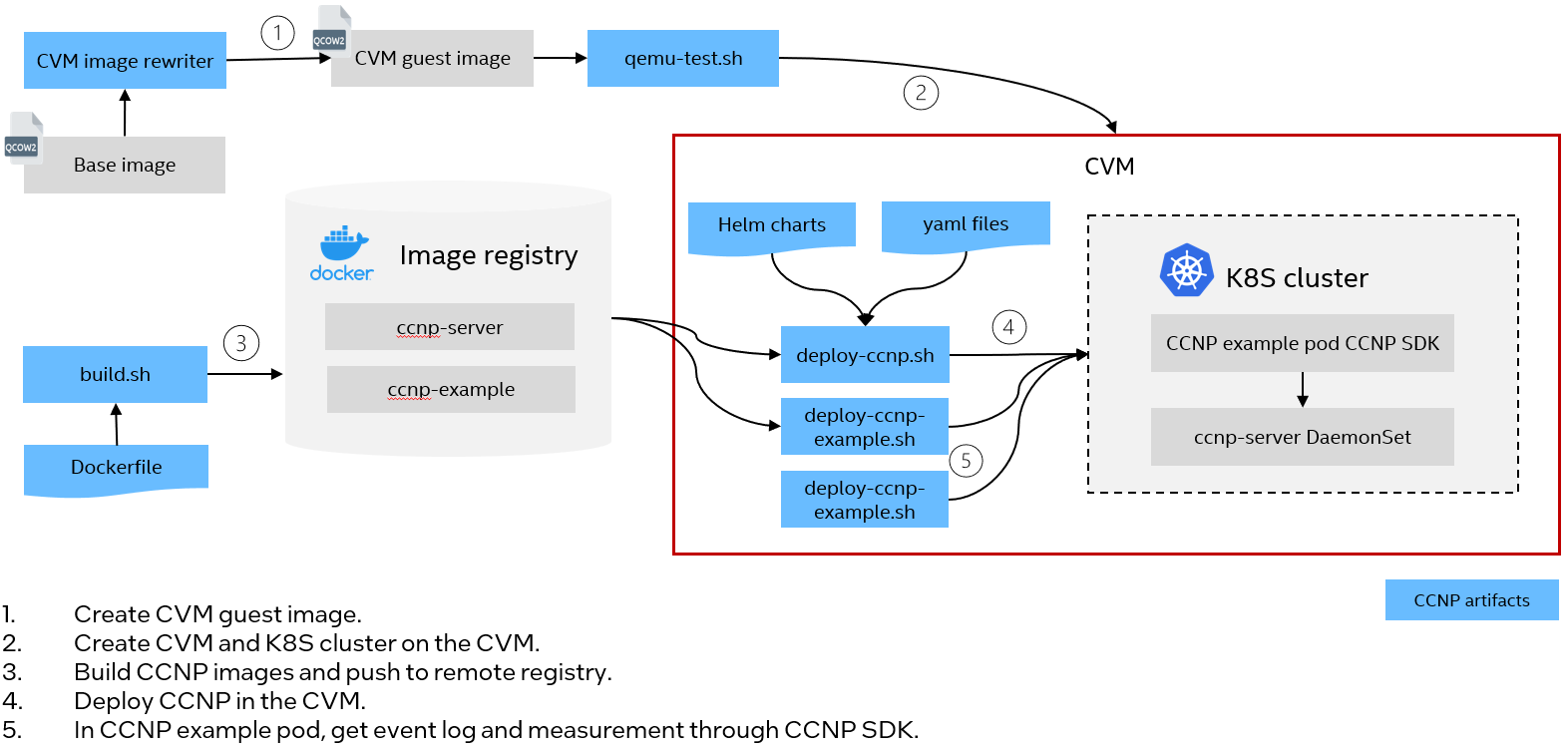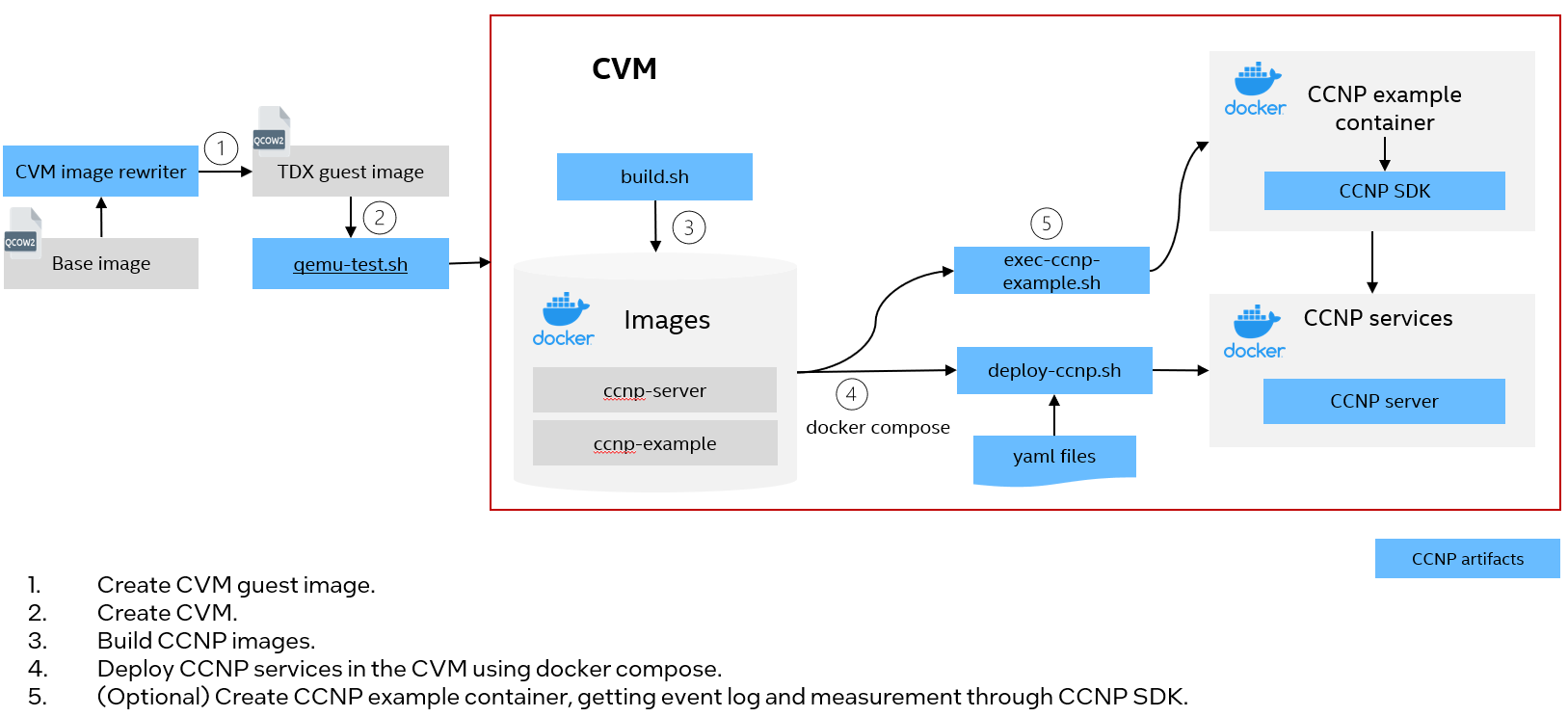CCNP Deployment Guide¶
CCNP is designed for collecting confidential computing primitives in cloud native environments. It can run as DaemonSet in a Kubernetes cluster or containers in a Docker environment on confidential virtual machines, such as Intel TDX guest(TD).
Build CCNP Kernel¶
Run build.sh to build kernel packages for CCNP. It’s recommended to run the tool on TDX host mentioned in Configuration.
It will generate a output folder including kernel packages. The folder will be used in the next step.
$ cd tools/build
$ sudo ./build.sh
NOTE:
Prepare TDX guest image¶
Run cvm image rewriter to prepare a TDX guest image for CCNP deployment. The default user name is tdx. The password is 123456.
It’s recommended to run the tool on TDX host mentioned in Configuration.
A quick start is as below.
# Download Ubuntu 23.10 cloud image (Skip this step if you already has an initial guest image.)
$ wget https://cloud-images.ubuntu.com/mantic/current/mantic-server-cloudimg-amd64.img
# Set file path of the generated output folder above. Plugin 06 will install the kernel in the guest image.
$ export CVM_TDX_GUEST_REPO=<path to above output folder>
# Set image size
$ export GUEST_SIZE=<image size>G
# Run CVM image rewriter to configure a TDX guest image for CCNP
$ cd tools/cvm-image-rewriter
$ ./run.sh -i <mantic-server-cloudimg-amd64.img or your initial guest image> -t <timeout in minutes, suggest to set to 15>
NOTE:
By default all the plugins will be executed. Generate a
NOT_RUNfile under the specific plugin folder if you want to skip it.It’s required to run plugin 06, 07, 08, 09 for CCNP.
Create a TD¶
Start a TD using qemu-test.sh or start-virt.sh.
Use
qemu-test.sh, please use-q <vsock>to make sure get quote works for the TD.$ sudo ./qemu-test.sh -i output.qcow2 -q vsock
Use
start-virt.sh. The Libvirt XML template is tdx-libvirt-ubuntu-host.xml.template. It usesvsockfor getting quote.$ sudo ./start-virt.sh -i <guest image>
Build CCNP images¶
Run script build.sh to generate CCNP images. It will generate 3 images and push them to user specific registry. Learn more details in the README.md.
NOTE:
The scripts need to run on a server with docker installed.
Run
docker loginbefore running the tool to make sure it can pull images.Set proxy server in your environment if needed. See more details in Configure Docker to use a proxy server.
$ cd container
$ sudo ./build.sh -r <remote registry> -g <docker image tag>
e.g.
# Build images with tag 0.3 and push them to remote registry test-registry.intel.com
$ sudo ./build.sh -r test-registry.intel.com/test -g 0.3
# Build images only with tag 0.3
$ sudo ./build.sh -a build -g 0.3
After the script is executed successfully, it’s supposed to see below docker images for CCNP.
$ sudo docker images
ccnp-example <your image tag>
ccnp-server <your image tag>
ccnp-device-plugin <your image tag>
Setup QGS and PCCS on the Host¶
Intel Quote Generation Service(QGS) and Provisioning Certification Caching Service(PCCS) should be installed and configured on the host for getting TD Quote. Please refer to Section 4.3.2, 4.3.3 and 4.3.4 of guide for QGS and PCCS installation.
Deploy CCNP in Kubernetes¶
Below diagram illustrates CCNP deployment process in a Kubernetes cluster. If you want to install CCNP services as DamonSets in the Kubernetes cluster, please refer to CCNP deployment in Kubernetes.

Deploy CCNP in Docker¶
Below diagram illustrates CCNP deployment process using docker compose. If you want to setup CCNP services as docker containers, please refer to CCNP deployment in Docker.
